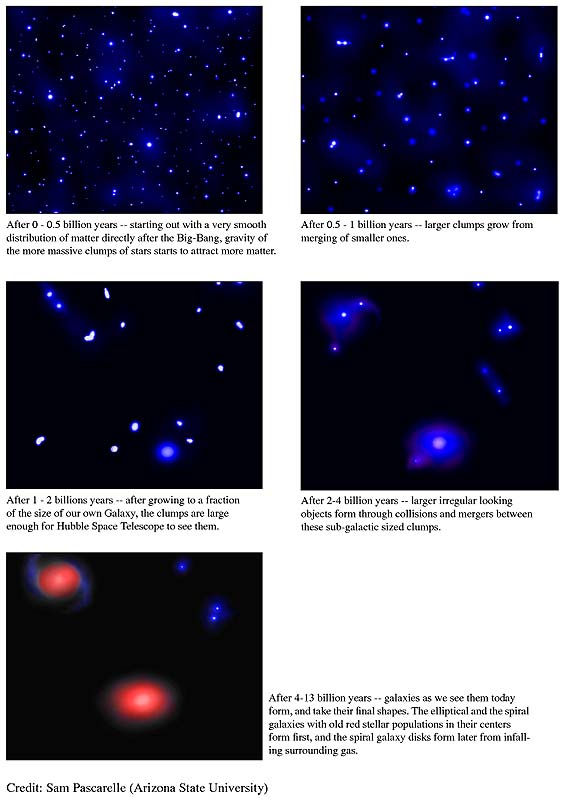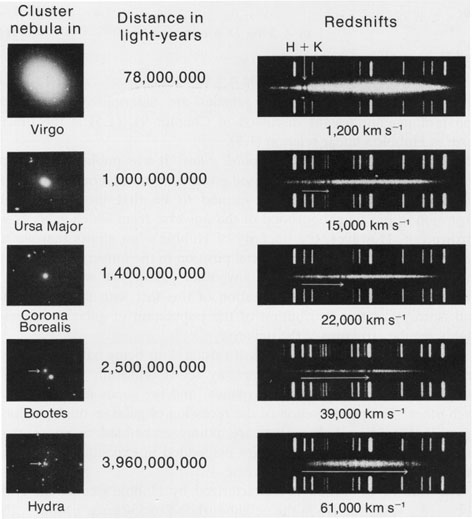
In the 1930's, Edwin Hubble discoveried that all galaxies have a positive redshift. In other words, all galaxies were receding from the Milky Way.

As it was later discoveried, the higher the redshift of an object, the farther away it is (Hubble's law). By the 1960's, the farthest objects detected were quasars.
The early radio surveys of the sky (in addition to discovering radio galaxies) also detected a number of radio sources that were called ``quasistellar'' radio sources, because, like stars, they were unresolved in visible images. The term ``QUASistellAR'' was shortened to quasar, the name by which this class of objects has since been called.
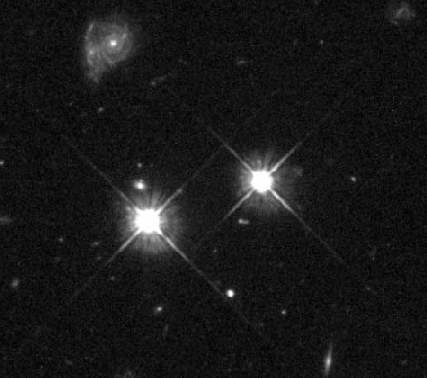
The most distant quasars are approximately 13 billion light years, away. To be seen at such immense distances, quasars must be very luminous -- even more luminous than a bright galaxy. Quasars have luminosities which lie in the range L = 10 to 10,000 times the luminosity of the Milky Way galaxy, 25 billion times the luminosity of the Sun. Thus, even the dimmest of the quasars are as bright as the brightest galaxies the vicinity of the Milky Way. The luminosity of quasars can vary significantly on timescales of only a week. Thus, the bulk of the immense luminosity of a quasar must be coming from a region only one light-week (1200 A.U.) across!
Quasars have a decidedly non-thermal spectrum: they are luminous in the X-rays, ultraviolet, visible, infrared, and radio bands. They have about the same power at all of the wavelengths down to the microwave wavelengths (shortwave radio wavelengths). The spectrum looks like the synchrotron radiation from charged particles spiralling around magnetic field lines at nearly the speed of light.
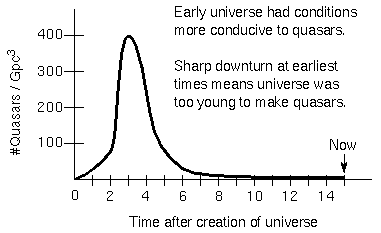
Quasars tend to be found at great distances from us; there are no nearby quasars. When we look at quasars, we see them as they were billions of years ago. The number of them increases at greater distances, so that must mean they were more common long ago. The number of quasars peaks at a time when the universe was about 20% of its current age. Back then the galaxies were closer together and collisions were more common than today. Also, the galaxies had more gas that had not been incorporated into stars yet. The number of quasars was hundreds of times greater than the time closer to the present. At very great distances the number of quasars drops off. The light from the most distant quasars are from a time in the universe before most of the galaxies had formed, so fewer quasars could be created.
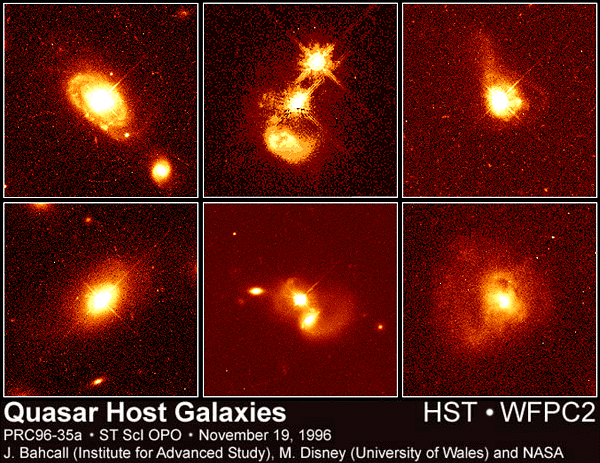
Astronomers are beginning to find the inactive supermassive black holes in some galaxies. In most galaxies the central black hole would have been smaller than the billions of solar mass black holes for quasars. This is why the less energetic active galaxies are more common than quasars. Our galaxy harbors a supermassive black hole in its core that has a mass of ``only'' 2.5 million solar masses. Astronomers are studying the cores of other normal galaxies to see if there are any signs of supermassive black holes that are now ``dead''.
Distant Galaxies:
Some types of galaxies are still forming stars at the present epoch (e.g. spiral and irregular galaxies). However, the past was marked by a much higher rate of star formation than the present-day average rate because there was more gas clouds in the past. Galaxies, themselves, were built in the past from high, initial rates of star formation.
The time of quasars is also during the time of first star formation in galaxies, so the two phenomenon are related, the past was a time of rapid change and violent activity in galaxies.
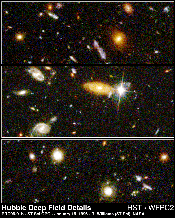
Space observations called the Hubble Deep Field produced of faint galaxies and distant galaxies at high redshift which confirmed, quantitatively, our estimates of the style and amount of star formation. Nature lends a hand by providing of distant galaxies by gravitational lensing, as seen in this HST image of CL0024.
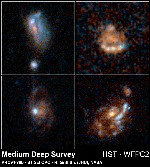
Interestingly enough, it is often easier to simulate the evolution of galaxies in a computer, then use the simulations to solve for various cosmological constants, such as Hubble's constant or the geometry of the Universe. The field of extragalactic studies is just such a process of iteration on the fundamental constants of the Universe and the behavior of galaxies with time (i.e. galaxy evolution).
The most distant galaxies are studied with a combination of the ground and space-based telescopes. Ground-based scopes for deep imaging of the light of distant galaxies, space-based to provide high resolution images of distant galaxies.
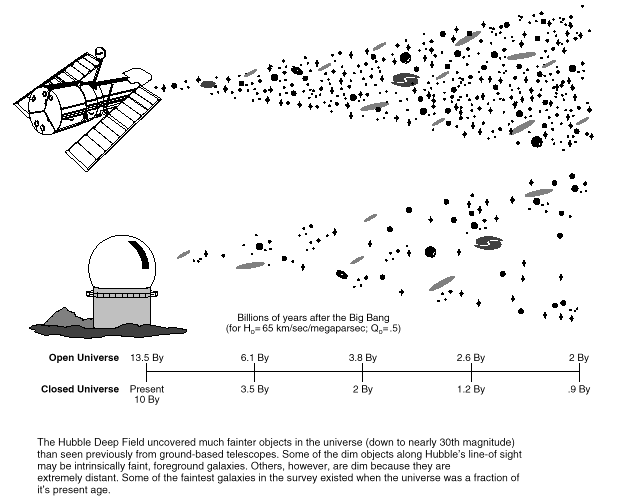
The most distant objects are found by the `dropout' method, where the high redshift of a galaxies means that the blue portion of its spectrum will have very little luminosity compared to its red light. The object appears to disappear or dropout in blue light.
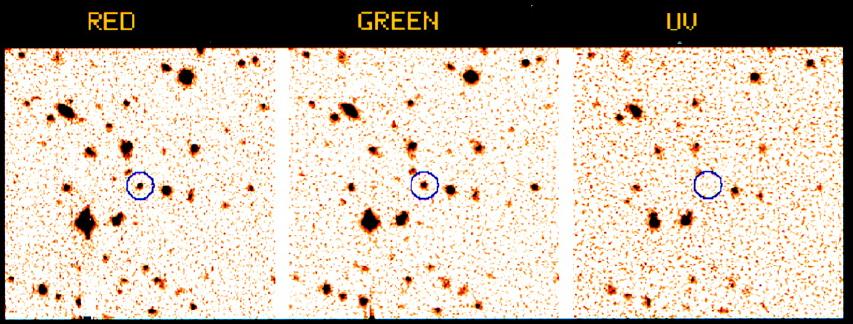
Galaxy Evolution:
The phenomenon of lookback time allows us to actually observe the evolution of galaxies. We are not seeing the same galaxies as today, but it is possible to trace the behavior of galaxies types with distance/time.
It is known that galaxies form from large clouds of gas in the early Universe. The gas collects under self-gravity and, at some point, the gas fragments into star cluster sized elements where star formation begins. Thus, we have the expectation that distant galaxies (i.e. younger galaxies) will be undergoing large amounts of star formation and producing hot stars = blue stars. The study of this phenomenon is called color evolution.
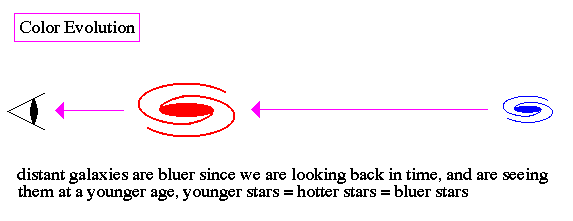
Computer simulations also indicate that the epoch right after galaxy formation is a time filled with many encounters/collisions between young galaxies. Galaxies that pass near each other can be captured in their mutual self-gravity and merge into a new galaxy. Note that this is unlike cars, which after collisions are not new types of cars, because galaxies are composed of many individual stars, not solid pieces of matter. The evolution of galaxies by mergers and collisions is called number evolution.
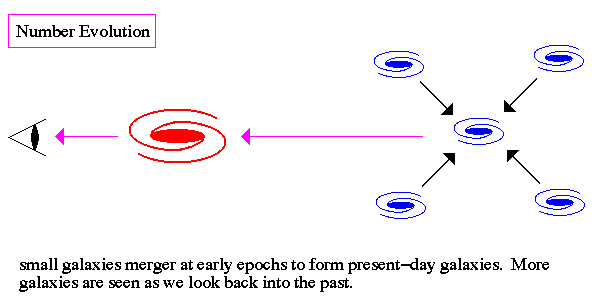
Thus, our picture of galaxy evolution, incorporating both these principles, looks like the following:
